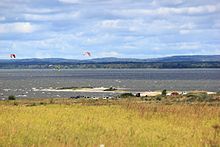Fresh lagoon
|
Fresh lagoon Zalew Wiślany |
|
|---|---|
| Coast at Frombork | |
| ocean | Atlantic Ocean |
| location | Poland , Russia |
| Tributaries | Nogat , Elbląg , Pregel |
| Affiliated seas | Gdańsk Bay |
| Cities on the shore | Elbląg , Frombork , Krynica Morska , Kaliningrad , Baltijsk |
| Data | |
| Satellite image | |
Coordinates: 54 ° 28 ′ 35 ″ N , 19 ° 46 ′ 4 ″ E
The Fresh Lagoon ( Polish: Zalew Wiślany , Russian: Калининградский залив Kaliningradski saliw ) is a lagoon in the Baltic Sea that belongs to the Russian Oblast of Kaliningrad in the north and to Poland in the south .
geography
The Fresh Lagoon begins about 40 kilometers east of Danzig near Elbląg (German Elbing) in the historical region of West Prussia and extends from there 70 to 80 kilometers in a north-easterly direction to the town of Primorsk (German Fischhausen) in the historical region of East Prussia .
The Fresh Lagoon is 860 km 2 in size, up to 80 kilometers long and up to 18 kilometers wide. The 70 km long and two km wide mainland strip of the Fresh Spit separates the lagoon from the Gdańsk Bay . The only passage between the lagoon and the Baltic Sea is the 380 m wide and 3-5 m deep Pillauer Tief in the (Russian) Baltijsk .
The Nogat , Elbing River , Passarge , Frisching and Pregel all flow into the lagoon .
The most important cities on or in the immediate vicinity of the Fresh Lagoon are Kaliningrad ( Königsberg ) and Baltijsk (German Pillau) in the Russian Oblast Kaliningrad and Elbląg in the Polish Warmian-Masurian Voivodeship .
Surname
At times the lagoon was also known as the “Frisian lagoon”. The name comes from the first German settlers on the spit, the Frisians . Over time, the term became "Fries'sches Haff" and later "Frisches Haff". In the book Speculum Germaniae or a brief geographical report of the whole of Germany from 1676, the location of Fischhausen , Frauenburg or Tolkemit on the “fresh lagoon” is mentioned. Meyer's Großes Konversations-Lexikon from 1907 mentions Frisching as the namesake.
In Russian it is called Fresh Lagoon Kaliningrad Bay ( Калининградский залив , Kaliningradski saliw), in Polish Zalew Wiślany (Weichselhaff) .
history
In 1924 and 1939, came to the epidemic of occurrence of fish poisoning in the northern part of the lagoon, which today considered Haffkrankheit (Engl. Haff disease ) is called.
The Freshness Lagoon and the Fresh Spit belonged to the German Empire until 1945 . When the Red Army advanced west at the end of the Second World War , it cut off tens of thousands of East Prussian refugees from the overland route, which is why they took the route across the frozen fresh lagoon. Thousands froze to death or died in Soviet air strikes, which consisted of both ice sheet bombing and machine gun fire.
After the end of the Second World War , the southern half of East Prussia and all of West Prussia were placed under Polish administration by the Soviet occupying power in accordance with the Potsdam Agreement . That is why the border between the Polish Warmian-Masurian Voivodeship and the Russian exclave Kaliningrad runs right across the Fresh Lagoon .
Weichselhaff Canal
Forgotten is the inland waterway over the Fresh Lagoon through the Weichselhaff Canal to the Vistula. Avoiding the sea route across the Baltic Sea, it connected Königsberg with Danzig. In the 1930s it was still important for the extensive brick industry on the lagoon and for the fruit trade.
New sea connection
The canal is currently being built through the Fresh Spit on Polish territory. The aim is to reactivate the port of Elbląg , which suffers from the fact that the only navigable connection to the Baltic Sea, the Pillauer Tief, is on Russian territory.
literature
- Frisches Haff (encyclopedia entry). In: Meyers Großes Konversations-Lexikon. 6th edition, Volume 7, Leipzig and Vienna 1907, p. 156.
- Bernhard Ohlert: Sketches from East Prussia. II. The fresh lagoon . Old Prussian Monthly, Vol. 3, Königsberg 1866, pp. 97–122 ( full text ).
- August Eduard Preuss : Prussian country and folklore or description of Prussia. Koenigsberg i. Pr. 1835, pp. 33-35 .
- The waterways of the province of Prussia. Comments on the eastern bank of the Fresh Lagoon and its surroundings . Archives for patriotic interests. New series, year 1845, Marienwerder 1845, pp. 634–641.
- Johann Christian Wutzke : Description of the fresh lagoon, the spit, the port near Pillau, etc. Preußische Provinzial-Blätter, Vol. 8, Königsberg 1832, pp. 356–364 , pp. 462–470 and pp. 594–604 ; Volume 9, Koenigsberg 1833, pp. 42-57 , pp. 151-165 , pp. 261-268 , pp. 429-440 and pp. 668-675 ; Volume 10, Koenigsberg 1833, pp. 101-108 and pp. 236-244.
- Karl Friedrich Vollrath Hoffmann : Germany and its inhabitants. A patriotic handbook for all estates. Stuttgart 1834, pp. 439-441.
Web links
- When the steamers drove across the lagoon (Landsmannschaft Ostpreußen)
Individual evidence
- ↑ Speculum Germaniae… . Nuremberg, 1676. Example: Frauenburg am frisch Haff, p. 458
- ^ Meyer's Large Conversational Lexicon . tape 7 . Leipzig 1907, p. 156 ( zeno.org [accessed October 10, 2017]).
- ↑ Cornelius Kutschke : The feeders of the port - a) The inland waterways , in: Königsberg as a port city . Königsberg 1930, p. 45.




